Square antiprism
| Uniform Square antiprism | |
|---|---|
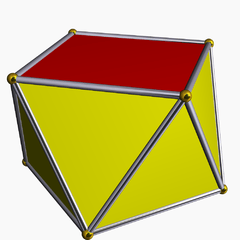 | |
| Type | Prismatic uniform polyhedron |
| Elements | F = 10, E = 16 V = 8 (χ = 2) |
| Faces by sides | 8{3}+2{4} |
| Schläfli symbol | s{2,8} sr{2,4} |
| Wythoff symbol | | 2 2 4 |
| Coxeter-Dynkin | |
| Symmetry group | D4d, [2+,8], (2*4), order 16 |
| Rotation group | D4, [4,2]+, (442), order 8 |
| References | U77(b) |
| Dual | Tetragonal trapezohedron |
| Properties | convex |
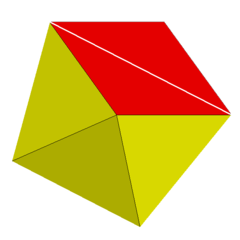 Vertex figure 3.3.3.4 | |
In geometry, the square antiprism is the second in an infinite set of antiprisms formed by an even-numbered sequence of triangle sides closed by two polygon caps. It is also known as an anticube.[1]
If all its faces are regular, it is a semiregular polyhedron or uniform polyhedron.
When eight points are distributed on the surface of a sphere with the aim of maximising the distance between them in some sense, the resulting shape corresponds to a square anti-prism rather than a cube. Specific methods of distributing the points include, for example, maximising the distance of each point to the nearest point, or minimising the sum of all reciprocals of squares of distances between points.
Molecules with square antiprismatic geometry

According to the VSEPR theory of molecular geometry in chemistry, which is based on the general principle of maximizing the distances between points, a square antiprism is the favoured geometry when eight pairs of electrons surround a central atom. One molecule with this geometry is the octafluoroxenate(VI) ion (XeF82−) in the salt nitrosonium octafluoroxenate(VI); however, the molecule is distorted away from the idealized square antiprism.[2]
In addition, the element sulfur forms octatomic S8 molecules as its most stable allotrope. The S8 molecule has a structure based on the square antiprism, in which the eight atoms occupy the eight vertices of the antiprism, and the eight triangle-triangle edges of the antiprism correspond to single covalent bonds between sulfur atoms.
In architecture
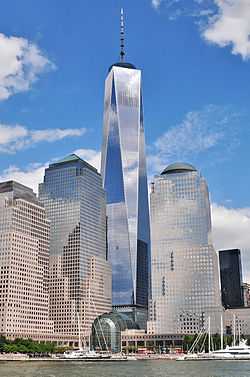
The main building block of the One World Trade Center (at the site of the old World Trade Center destroyed on September 11, 2001) has the shape of an extremely tall square antiprism.
Variations
A twisted prism can be made (clockwise or counterclockwise) with the same vertex arrangement. It can be seen as the convex form with 4 tetrahedrons excavated around the sides. However after this it can no longer be triangulated into tetrahedra without adding new vertices. It has half of the symmetry of the uniform solution: Dn, [4,2]+, order 8.[3][4]
Related polyhedra
As an antiprism, the square antiprism belongs to a family of polyhedra that includes the octahedron (which can be seen as a triangle-capped antiprism), the pentagonal antiprism, the hexagonal antiprism, and the octagonal antiprism.
The gyroelongated square pyramid is a Johnson solid (specifically, J10) constructed by replacing one square of a square antiprism with a square pyramid. Similarly, the gyroelongated square bipyramid (J17) is a deltahedron (a polyhedron whose faces are all equilateral triangles) constructed by replacing both squares of a square antiprism with a square pyramid.
The snub disphenoid (J84) is another deltahedron, constructed by replacing the two squares of a square antiprism by pairs of equilateral triangles. The snub square antiprism (J85) can be seen as a square antiprism with a chain of equilateral triangles inserted around the middle. The sphenocorona (J86) and the sphenomegacorona (J88) are other Johnson solids that, like the square antiprism, consist of two squares and an even number of equilateral triangles.
The square antiprism is first in a series of snub polyhedra and tilings with vertex figure 3.3.4.3.n.
| Symmetry 4n2 [n,4]+ |
Spherical | Euclidean | Compact hyperbolic | Paracompact | ||||
|---|---|---|---|---|---|---|---|---|
| 242 [2,4]+ |
342 [3,4]+ |
442 [4,4]+ |
542 [5,4]+ |
642 [6,4]+ |
742 [7,4]+ |
842 [8,4]+... |
∞42 [∞,4]+ | |
| Snub figure |
 3.3.4.3.2 |
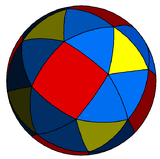 3.3.4.3.3 |
 3.3.4.3.4 |
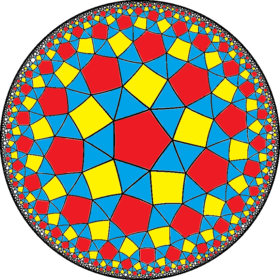 3.3.4.3.5 |
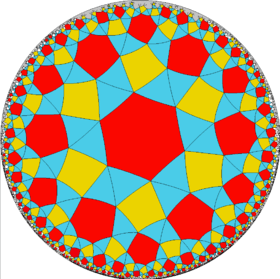 3.3.4.3.6 |
 3.3.4.3.7 |
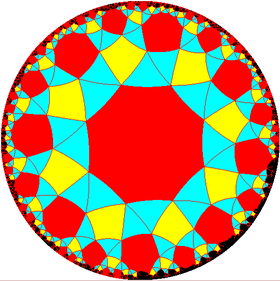 3.3.4.3.8 |
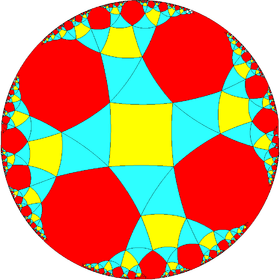 3.3.4.3.∞ |
| Coxeter Schläfli |
sr{2,4} |
sr{3,4} |
sr{4,4} |
sr{5,4} |
sr{6,4} |
sr{7,4} |
sr{8,4} |
sr{∞,4} |
| Snub dual figure |
 V3.3.4.3.2 |
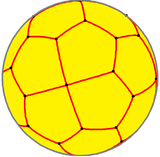 V3.3.4.3.3 |
 V3.3.4.3.4 |
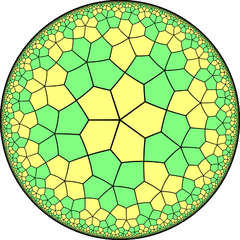 V3.3.4.3.5 |
V3.3.4.3.6 | V3.3.4.3.7 | V3.3.4.3.8 | V3.3.4.3.∞ |
| Coxeter | ||||||||
The square antiprism can be truncated and alternated to form a snub antiprism:
| Antiprism | Truncated t |
Alternated ht |
|---|---|---|
 s{2,8} |
 ts{2,8} |
 ss{2,8} |
See also
| 2 | 3 | 4 | 5 | 6 | 7 | 8 | 9 | 10 | 11 | 12 | n |
|---|---|---|---|---|---|---|---|---|---|---|---|
| s{2,4} sr{2,2} |
s{2,6} sr{2,3} |
s{2,8} sr{2,4} |
s{2,10} sr{2,5} |
s{2,12} sr{2,6} |
s{2,14} sr{2,7} |
s{2,16} sr{2,8} |
s{2,18} sr{2,9} |
s{2,20} sr{2,10} |
s{2,22} sr{2,11} |
s{2,24} sr{2,12} |
s{2,2n} sr{2,n} |
| As spherical polyhedra | |||||||||||
Notes
- ↑ Holleman-Wiberg. Inorganic Chemistry, Academic Press, Italy, p. 299. ISBN 0-12-352651-5.
- ↑ Peterson, W.; Holloway, H.; Coyle, A.; Williams, M. (Sep 1971). "Antiprismatic Coordination about Xenon: the Structure of Nitrosonium Octafluoroxenate(VI)". Science 173 (4003): 1238–1239. Bibcode:1971Sci...173.1238P. doi:10.1126/science.173.4003.1238. ISSN 0036-8075. PMID 17775218.
- ↑ The facts on file: Geometry handbook, Catherine A. Gorini, 2003, ISBN 0-8160-4875-4, p.172
- ↑
External links
- Weisstein, Eric W., "Antiprism", MathWorld.
- Square Antiprism interactive model
- Virtual Reality Polyhedra www.georgehart.com: The Encyclopedia of Polyhedra
- VRML model
- Conway Notation for Polyhedra Try: "A4"
| ||||||||||||||||||||||||||||||||||||
